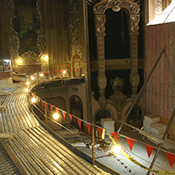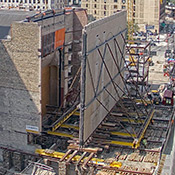
A Look Ahead: Incorporating An Organ Into Our New Hall
David Lewellen
PUBLISHED
Tagged Under: Grand Theater, In the News, Musician, Organ
Milwaukee Symphony audiences will enjoy Saint-Saëns’s Organ Symphony next weekend. But the next time they hear it will probably be on a brand-new, still-unbuilt organ in the new concert hall.
As work continues to restore the Warner Grand Theater, some donors and concertgoers have noticed that the hall will not have an organ in place for its grand reopening in the fall of 2020. But symphony officials’ plan all along has been to design, build and install a new instrument within a few years of moving into the new facility.
Money is one reason to delay – a new organ might cost several million dollars and will require a separate fund-raising campaign from the new hall. But another reason, equally practical, is dust. “Construction creates a lot of dust,” said John Roloff, the symphony’s director of operations and facilities, “and dust in the pipes is really bad for an organ.” Waiting until all construction was finished to start work on the organ could delay opening the hall by six months, he said, “and we want to get in as soon as possible.” That is why many new venues, such as Walt Disney Concert Hall in Los Angeles, have premiered their organ a year or two later.
Also, Roloff said, “An organ is a bespoke instrument. You don’t just pull one off the shelf.” A year of playing in the hall will yield information about the acoustics that will go into the design of the MSO’s new organ.
Space has been designed, and will be saved, for organ pipes above and behind the choir loft in the new hall. A room for the blower and other mechanical equipment is also built into the plans.
The current organ in Uihlein Hall, a multipurpose facility, is stored in the basement and brought to the stage by a hydraulic lift in weeks when the MSO performs repertoire that includes organ. It’s an unusual setup, and simply moving it would present different challenges, because the new venue has completely different acoustics than Uihlein.
The original organ installed in the Warner Grand was moved at one point to the Oriental Theater. Even if it weren’t, Roloff said, “A theater organ from the first half of the 20th century is very different from a symphonic organ.”
The Saint-Saens is probably the most famous work for orchestra with organ, but there are plenty of others that use it in a quieter role. For the first season or two in the new hall, those decisions will be case by case, Roloff said. Sometimes the conductor prefers skipping the organ altogether, and sometimes a smaller portative organ can be substituted – which is already the norm when the MSO performs Handel’s Messiah in churches in December. (Most churches have their own organs, of course, but the features of each one are different, and they are frequently situated too far from where the orchestra sits.)
David Jonies, who will play the Saint-Saëns organ part with the symphony next week, is the organist of Holy Name Cathedral in Chicago, and has played with the MSO in recent years for Holst’s The Planets and Vaughan Williams’s A Sea Symphony. The organ plays a more prominent role in the Saint-Saëns, but “it’s not an organ concerto,” Jonies said. “It’s truly part of the symphonic fabric, and it weaves in and out of the music.” The organ plays only in the second movement as “a soft carpet of sound under the orchestra,” and in the fourth, setting the tone with a blast of C major on the downbeat.
One mark of a good symphony organ, Jonies said, is many “enclosed divisions,” or ranks of pipes in a box with slats that can open or close, to allow control of dynamics. “Only an organ of a certain size will have that,” he said. “It’s not how loud the organ can be, it’s more how soft the organ can be.”
“We fully plan on having an organ at some point in the near future,” Roloff said. “A wonderful organ is a critical part of a symphonic concert hall.”



